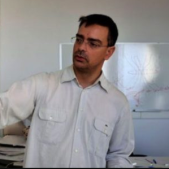
The first who shed light on the birth of stars
Dr. Aris Τritsis and Kostas Tassis, an assistant professor at the University of Crete in the Department of Physics, are the first researchers in the world who managed to map a three-dimensional molecular interstellar cloud of gas and dust, a place where new stars are born. Their new discovery shows that the cloud’s magnetic field vibrates as if producing sound, a revelation that opens new ways of solving one of the biggest mysteries in astrophysics “What is it that determines the number and type of stars and planets created in our Milky Way?”
Aris Tritsis studied Physics at the University of Ioannina (UoI) and, in 2013, he graduated with a master’s degree in Astrophysics from the University College of London (UCL), while in 2017 he received his Ph.D. from the University of Crete (UoC) under the supervision of Kostas Tassis. Moreover, he is a postdoctoral fellow at the Research School of Astronomy and Astrophysics at Mount Stromlo Observatory and works in Christoph Federrath’s research group.
Kostas Tassis got his Physics degree from the Aristotle University of Thessaloniki in 1999, and his Ph.D. from the University of Illinois at Urbana-Champaign (USA), in 2005. He worked as a postdoctoral fellow at the University of Chicago (2005-2008) and Jet Propulsion Laboratory of NASA and the California Institute of Technology (Caltech, 2008-2011). He was elected assistant professor in the Department of Physics in 2011 and came to Crete in the autumn of 2012. In the years 2011-2012, he was a Visiting Researcher at the Max-Planck Institute for Radioastronomy in Bonn, Germany. Moreover, he is the assistant professor who undertook the implementation of PASIPHAE experiment in the Institute of Electronic Structure and Laser in 2017, the financing of which is taken on by the European Research Council (ERC).
Their discovery was published in the journal Science and was the core of Dr. Tritsi’s doctoral thesis, which he completed at the Physics Department of the University of Crete, under the supervision of Professor Kostas Tassis. It was based on theoretical and experimental studies of the two researchers, at the University of Crete and the Foundation for Research and Technology, as well as on data from the Herschel Space Observatory of the European Space Agency (ESA).
“The process of astrogenesis remains one of the greatest unsolved problems in astrophysics,” said Mr. Tassis to AΠΕ-ΜΠΕ, “We know that stars are born in interstellar gas clouds of “astronomical” sizes, but what exactly happens between a cloud turning into a star, like our sun and the planets, is still a mystery. What determines whether a cloud will produce many small or few big stars? What percentage of the gas cloud will turn into stars and how much will be recycled?”.
The physical processes that determine the astrogenesis process, leaves its mark on the three-dimensional shape of the clouds. These traces could help scientists decipher the natural processes of the birth of any star. But until now that was impossible because even the most advanced telescopes can only map the two-dimensional view of clouds and not their three-dimensional structure.
This is precisely the Greek researcher’s innovation. They studied the case of Mouska (Musca), a large isolated cloud visible from the southern hemisphere, which resembles a thin cylinder like a needle in the sky. The cloud consists essentially of molecular hydrogen and it is located at a distance of 570 light years from Earth, slightly below The Southern Cross constellation. It has a length of about 27 years of light and a depth of 20 light years according to the researcher’s estimations.
The Greek scientists discovered that the whole of Musca’s magnetic field vibrates producing sounds. The frequencies of those sounds reveal Musca’s actual three-dimensional shape, just like musical instrument frequencies. A small drum makes a different sound from a large drum. In the same way, they calculated that the width is comparable with the visible length of the cloud in the sky.
“Musca is the largest object in the Galaxy that pulsates”, according to Aris Tritsis, “Knowledge of the three-dimensional shape of clouds will greatly improve our understanding about these Maternity stars and the birth of our Solar System. Musca can now be used as a Lab to control theories on the formation of stars and spatial dust”.
“This is the first time we saw the Song of an object this large, the first object in the Galaxy for which such characteristic frequencies of magnetic vibrations were observed. It is also the first time that a cloud’s Magnetic Song was used to decrypt its actual shape. It is a great pleasure for us that this survey was carried out not only by Greek scientists, but also in Greece, at the University of Crete and FRT, and is the result of a doctoral thesis carried out entirely in our country”.
“It was a big surprise”, Kostas Tassis added, “because Musca was considered by all astrophysicists the pattern of a thin cylindrical cloud until now. The Song proved the opposite; it is of round shape and we just happened to see it from its thin side. This pattern strongly suggests that the magnetic field of the galaxy plays an active role in the formation and structure of interstellar clouds. This discovery allowed us to simulate the structure in detail, thus opening the way for scientists who wish to use it as an exemplary Laboratory, where we can study the astrogenesis process with great details”.
The pioneering research which works on the field of magnetic asteroseismology was funded by the European programs FP7 Marie Curie, ERC-CoG, and REGPOT and used the supercomputer of Metropolis HPC at the Center for Quantum Complexity and Nanotechnology in Crete.














